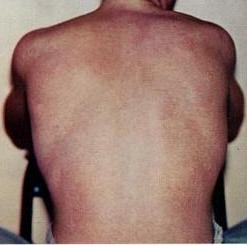Dengue fever physical examination: Difference between revisions
| Line 26: | Line 26: | ||
*Hypotension for age; | *Hypotension for age; | ||
*Cold, clammy skin and restlessness. | *Cold, clammy skin and restlessness. | ||
==References== | ==References== | ||
{{Reflist|2}} | {{Reflist|2}} | ||
Revision as of 14:07, 28 August 2012
|
Dengue Fever Microchapters |
|
Diagnosis |
|---|
|
Treatment |
|
Case Studies |
|
Dengue fever physical examination On the Web |
|
American Roentgen Ray Society Images of Dengue fever physical examination |
|
Risk calculators and risk factors for Dengue fever physical examination |
Editor-In-Chief: C. Michael Gibson, M.S., M.D. [1]
Overview
Physical Examination
-
The above picture is a rash typically associated with Dengue fever.
Appearance of the Patient
The diagnosis of dengue is usually made clinically. The classic picture is high fever with no localising source of infection, a petechial rash with thrombocytopenia and relative leukopenia.
There exists a WHO definition of dengue haemorrhagic fever that has been in use since 1975; all four criteria must be fulfilled:
- Fever
- Haemorrhagic tendency (positive tourniquet test, spontaneous bruising, bleeding from mucosa, gingiva, injection sites, etc.; vomiting blood, or bloody diarrhea)
- Thrombocytopaenia (<100,000 platelets per mm³ or estimated as less than 3 platelets per high power field)
- Evidence of plasma leakage (hematocrit more than 20% higher than expected, or drop in haematocrit of 20% or more from baseline following IV fluid, pleural effusion, ascites, hypoproteinaemia)
Dengue shock syndrome is defined as dengue haemorrhagic fever plus:
- Weak rapid pulse,
- Narrow pulse pressure (less than 20 mm Hg)
or,
- Hypotension for age;
- Cold, clammy skin and restlessness.
